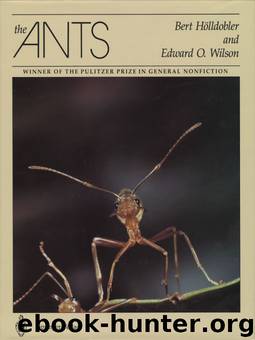The Ants by Edward O. Wilson & Bert Hölldobler

Author:Edward O. Wilson & Bert Hölldobler [Wilson, Edward O.]
Language: eng
Format: mobi, epub
Publisher: Apress - A
Published: 1990-03-22T05:00:00+00:00
Another factor to examine is the means by which workers recognize colony odor at the species level. If they have a fully innate, “hard-wired” recognition separating individuals of the same species from those of different species, they will be very resistant in evolution to the intrusion of social parasites. If, on the other hand, they learn the species odor early in life, they can be more easily duped. A worker captured by a slavemaker while still in the pupal or callow (newly eclosed) adult stage can be imprinted on the odor of the captor. She will serve automatically as a slave thereafter.
The relative flexibility of early learning of conspecific brood labels may also play a role. Extensive research has been conducted on the recognition of brood (immature stages) by ants of the genus Formica (Jaisson, 1975, 1985; Le Moli and Passetti, 1977, 1978; Jaisson and Fresneau, 1978; Le Moli and Mori, 1982). The results demonstrate that young adult workers learn to recognize whatever species of brood they encounter within a period of approximately one week after their emergence from the cocoon. Unfamiliar brood pieces, whether of another species or their own, are rejected or destroyed. It has been suggested that an early learning of brood labels has favored the repeated evolution of slave making and social parasitism among ants. Le Moli (1980) and later Brian (1983) argued that the only species suitable as hosts or slaves are those in which brood recognition is based on learning without any bias favoring individuals of the same species. This preadaptive flexibility would ensure that immature slave or host ants, when eclosing, would learn the brood labels of their own species as well as those of their parasites.
The Brian-Le Moli hypothesis is only partially supported by the evidence, however. Formica rufa and F. lugubris, which do not exhibit a bias for learning conspecific brood labels, are not themselves victims of parasitism, although they are temporary social parasites of other Formica species (Gosswald, 1951a; Kutter, 1969). F. polyctena, which is usually free-living, is occasionally parasitized by F. truncorum (Kutter, 1969). Preference for early learning of conspecific brood labels has been found in Camponotus (Carlin et al., 1987a,b). It is tempting to attribute the “immunity” to social parasitism of the genus Camponotus to this bias of learning conspecific brood labels. These facts appear to support the Brian-Le Moli hypothesis. Since the bias discovered in Camponotus is not exclusive, however, colonies should still be vulnerable to potential parasites. Le Moli cites as supporting evidence his discovery that Lasius niger does not learn brood labels at an early age, and he uses the trait to explain why L. niger is evidently immune against social parasitism. He overlooks the fact, however, that L. niger serves as the host of the temporary social parasites L. umbratus (Crawley, 1909; Gösswald, 1938a; Hölldobler, 1953) and L. fuliginosus (Andrasfalvy, 1961).
To summarize, we can recognize several predisposing features toward social parasitism that might explain why it occurs in some ant genera and not in others.
Download
The Ants by Edward O. Wilson & Bert Hölldobler.epub
This site does not store any files on its server. We only index and link to content provided by other sites. Please contact the content providers to delete copyright contents if any and email us, we'll remove relevant links or contents immediately.
Sapiens: A Brief History of Humankind by Yuval Noah Harari(14322)
The Tidewater Tales by John Barth(12627)
Mastermind: How to Think Like Sherlock Holmes by Maria Konnikova(7281)
Do No Harm Stories of Life, Death and Brain Surgery by Henry Marsh(6908)
The Thirst by Nesbo Jo(6882)
Why We Sleep: Unlocking the Power of Sleep and Dreams by Matthew Walker(6659)
Life 3.0: Being Human in the Age of Artificial Intelligence by Tegmark Max(5519)
Sapiens by Yuval Noah Harari(5325)
The Longevity Diet by Valter Longo(5044)
The Body: A Guide for Occupants by Bill Bryson(5033)
The Rules Do Not Apply by Ariel Levy(4912)
The Immortal Life of Henrietta Lacks by Rebecca Skloot(4552)
Animal Frequency by Melissa Alvarez(4430)
Why We Sleep by Matthew Walker(4395)
The Hacking of the American Mind by Robert H. Lustig(4342)
Yoga Anatomy by Kaminoff Leslie(4334)
All Creatures Great and Small by James Herriot(4277)
Double Down (Diary of a Wimpy Kid Book 11) by Jeff Kinney(4244)
Embedded Programming with Modern C++ Cookbook by Igor Viarheichyk(4143)
